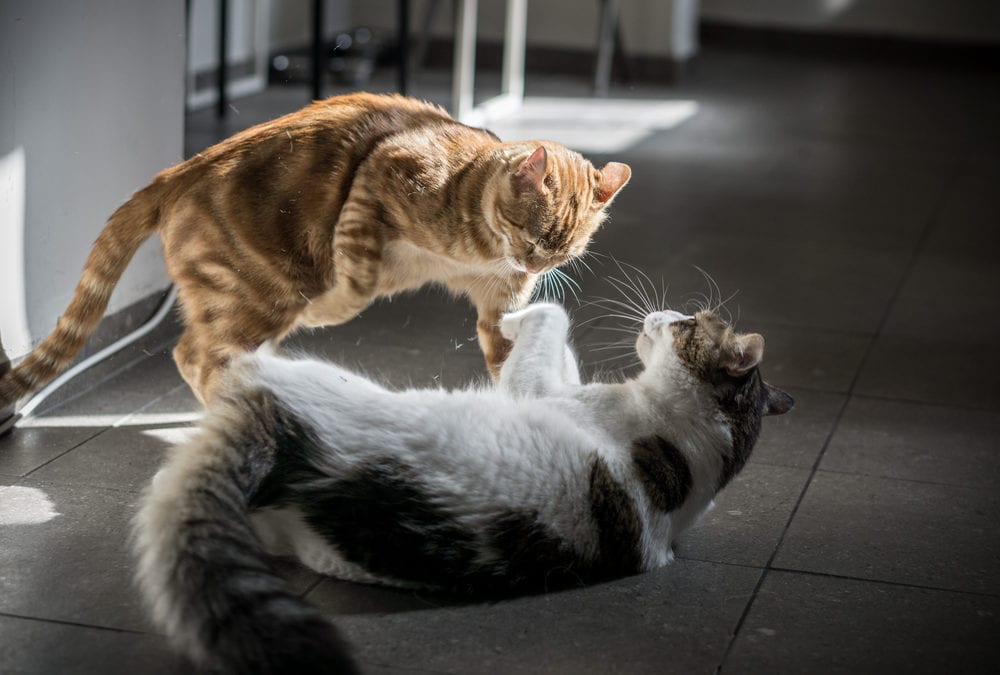Common Cat Behavior Problems
It’s the middle of the night and you hear your cats zooming around the house, knocking things over and getting into fights. This is probably not the first time you’ve heard this or will be the last. These occasional fights among cats may not sound like much of a behavioral problem. Before you write them off as normal, consider how often these fights occur day-to-day. Cats need exercise, a healthy lifestyle, and socialization in order to live a good, long life. A fight here and there may seem like nothing, but what if it’s all the time or is affecting the household dynamic? This is where the team at Union Lake Pet Services would like to offer some insight
Reasons for Cat Behavior Problems
There are three issues that can be undermining your efforts to create a happy home among your cat companions. If chronic “drama” is happening, the cause is often one of these three.
1. Medical Problems
Pain is a cause of irritability, aggression, and hiding in cats, just as you might feel less than agreeable when you experience pain. If you notice that your cat is acting up, take a look at any other changes that you may have previously overlooked. Is he limping? Has his appetite changed, or how much is he sleeping?
Also, when a cat is urinating or leaving feces around the house, it may not be a cat behavior issue. Spraying and defecating outside of the box (which may trigger other cats) can signal a health concern.
Take these notes to your veterinarian for a thorough examination to determine if medical issues are adding to the problem.
2. Lack of Exercise
It should come as no surprise that cats need exercise. In the wild, they’re some of the most agile, active, and speedy animals around. Domestic cats are no different, despite how much they love those cat naps. A cat who doesn’t get enough activity will be at risk of aggression or destructive behavior, as well as obesity and its complications. Think of it this way, a well-exercised cat will:
- Have less anxiety
- Won’t be as destructive, since their attention will be redirected into exercise
- Have less energy to fight the other cats (or you, if that is the problem)
- Won’t be bored (exercise is a great enrichment tool)
Running and playing with toys are two different forms of good exercise for your cat. A laser pointer can help inspire full-on sprees. Clear an area in the home to be open enough for zooms. Strings or wands with feathers attached are some of the best, and cheapest, toys a cat could have. If your cat has high energy, you could consider getting a cat running wheel.
3. No Place to Get Away
Most animals, including cats and even the sociable dog, need a safe place to get away. Whether that is a spot on top of the cat tree or a cozy place in a closet. These safe spots allow for privacy and an escape from what your pet perceives as stressful.
Cats in the wild will climb when they need to escape, and this instinct isn’t lost on their domestic counterparts. Felines have always been climbers by nature. Most wild cats naturally climb trees, rocks, or anywhere they can be up high and hidden. It is important that the cats in your house have ample space to climb up and away in order to have some solitary cat space.
One good way of doing this might be installing cat shelves. You can buy them at places like Amazon as a set or build your own. You can also buy cat towers or simply clear a space on top of the fridge or cabinets for your kitty friend.
A Healthy Cat Is a Happy Cat
Whether or not one of these three issues is the cause of your cat woes, they are all things a cat needs in their life. A healthy lifestyle of exercise, ample space and privacy, and regular vet checkups will go a long way in increasing contentment in the life of your cat and preventing cat behavior problems. In order to understand what your furry friend is in need of, and reduce cat behavioral issues in the home, please visit your vet or one of us here at ULPS. Many meows and happy tails to you in the meantime.

